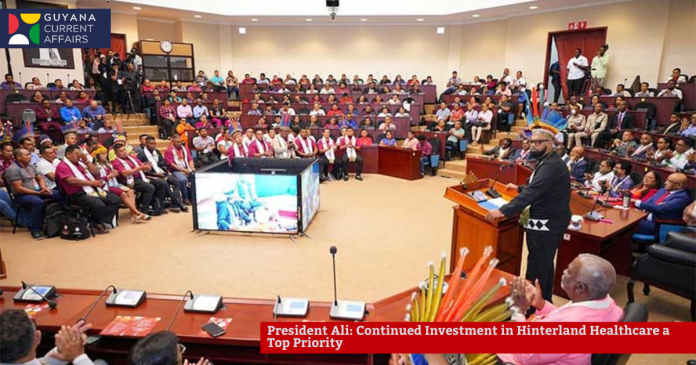President Dr. Irfaan Ali has reaffirmed his government’s unwavering commitment to expanding and modernizing healthcare services across Guyana’s hinterland regions, highlighting a series of sweeping improvements and pledging ongoing investment to ensure equitable access for all citizens.
Speaking at the opening of the 2025 National Toshaos Council Conference, President Ali outlined the government’s achievements since 2020, pointing to a dramatic transformation in health outcomes and infrastructure in Indigenous and remote communities. He emphasized that these advances are not isolated efforts but part of a sustained, long-term strategy to bridge the gap between hinterland and coastal healthcare.
Major Improvements Across Regions
In Region One (Barima-Waini), the President noted a shift from zero surgeries and minimal medical supplies before 2020 to over 500 surgeries performed at the Mabaruma Regional Hospital last year. The availability of medication has soared from less than 30% to 95%, and the region now boasts its own oxygen generation facilities, vaccine refrigeration, and 17 telemedicine centers. Referrals to Georgetown for critical cases have plummeted, reflecting the enhanced capacity of local hospitals.
Region Seven (Cuyuni-Mazaruni) has seen billions invested, with more than 45 vehicles and boats added to the medical fleet, 24 health outreaches conducted in 2024 alone, and 43 new community health workers trained. The availability of essential drugs and supplies has nearly doubled, and new medical specialties have been introduced.
In Region Eight (Potaro-Siparuni), the number of annual health outreaches has increased, and the region recorded its first elective surgeries last year. The government has also prioritized the completion of the new Kato Hospital and upgrades to Mahdia Hospital and other health centers.
Region Nine (Upper Takutu-Upper Essequibo) has experienced a healthcare revolution, with over 1,200 surgeries performed at Lethem Hospital in 2024 alone. The region now attracts patients from neighboring Brazil, a reversal of previous trends. The percentage of critical pregnancies requiring transfer out of the region has dropped from 90% to under 2%, and more than 550 healthcare professionals have been trained locally.
Ongoing and Future Investments
President Ali announced that the government will continue to invest in the expansion of laboratory services, the implementation of electronic health record systems, and the construction of new hospitals and accommodation for medical staff. Plans are also underway to upgrade health centers to polyclinics and to further expand telemedicine networks.
He stressed that these investments are not just about infrastructure, but also about empowering local communities through training and employment in the health sector. A majority of new nurses and healthcare workers in the hinterland are Indigenous, a direct result of targeted educational investments.
A Commitment to Equity and Quality
President Ali assured hinterland residents that the government’s commitment is constant and not opportunistic. “We are not seasonal. We are your constants. We are not opportunistic. We are your everyday as you are our everyday,” he stated, underscoring the administration’s focus on sustainable development.
The President concluded by highlighting the broader vision: eliminating malaria in the hinterland by 2030, ensuring every region has modern healthcare facilities, and guaranteeing that no community is left behind as Guyana’s health sector continues to evolve.
The government’s record and ongoing plans signal a new era for healthcare in Guyana’s hinterland, with transformative benefits for Indigenous and remote communities.


